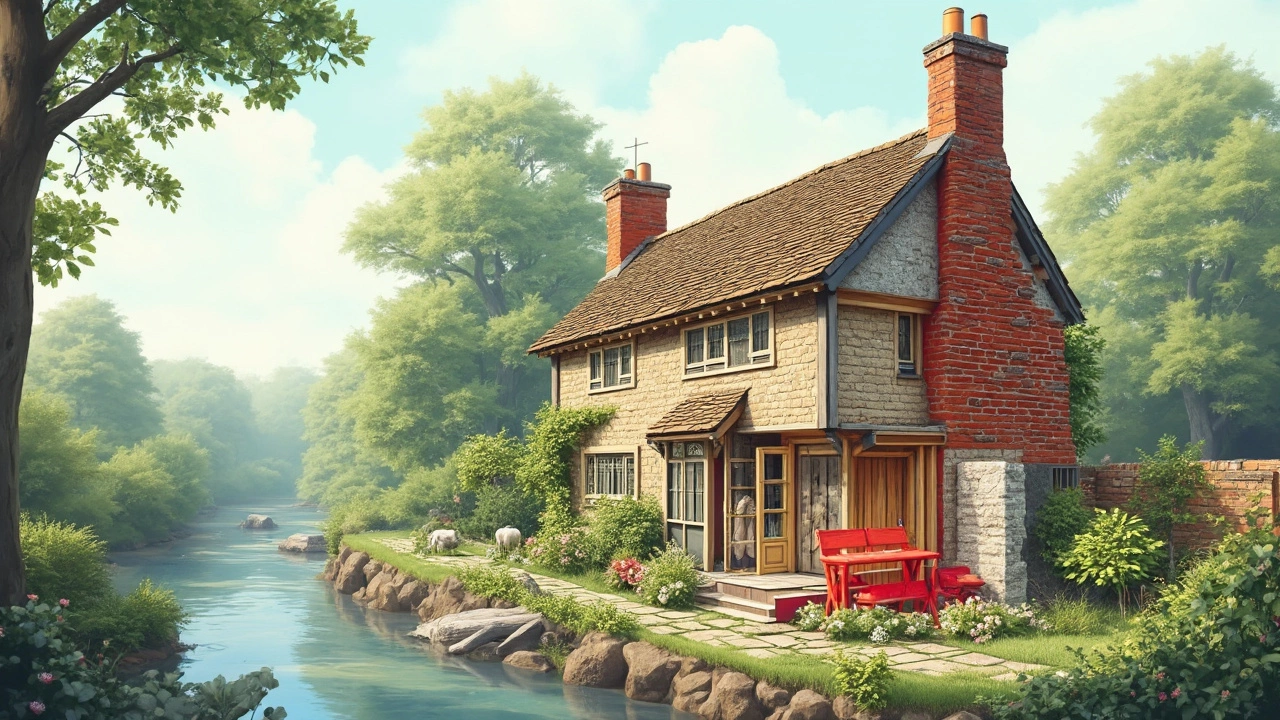Eco-Friendly Cottages: What Building Materials Should You Avoid?
21 May, 2025Thinking about building a green cottage? Picking the right materials is a game changer. Some common options look harmless but are actually terrible for the planet. Steel, concrete, and traditional bricks—they’re everywhere, but not all they’re cracked up to be when you look closer.
The stuff you build with shapes your home’s carbon footprint for decades. For example, manufacturing one ton of cement spits out nearly the same amount of CO2. That means just laying your cottage’s foundation already leaves a chunky mark on the climate. Don’t even get me started on old-school fiberglass insulation, which takes loads of energy to make and doesn’t break down—so it’ll stick around long after you’re gone.
If eco-friendliness is your goal, you’ll want to know what to dodge and what to use instead. Let’s run through the worst picks and some shocking facts behind them. You’ll leave armed with practical tips so you can build a cottage that looks good, feels good, and does right by the earth.
- Why Material Choice Matters
- The Worst Offenders: Non-Eco Materials
- Hidden Impact: Less Obvious Culprits
- Better Choices: What to Use Instead
Why Material Choice Matters
Building a cottage isn’t just about the look and feel—it’s about the long-term impact, too. The stuff you use to build your place can do a lot more harm to the planet than you’d think. Some materials use tons of energy just to exist, pollute waterways during production, or stick around for centuries after you’re done with them.
Here’s the thing: The construction industry pumps out roughly 11% of global CO2 emissions. That’s a big chunk, and a lot of it comes from our building materials choices. Take cement, the main ingredient in concrete. For every ton of cement made, almost a ton of carbon dioxide gets released—mainly because it takes crazy high heat to produce.
Check out how much energy and emissions come from some typical materials:
| Material | CO2 Emissions (kg/ton) | Energy Use (kWh/ton) |
|---|---|---|
| Cement | 900 | 1,200 |
| Steel | 1,850 | 7,000 |
| Brick (fired clay) | 220 | 1,700 |
| Wood (engineered) | 30 | 500 |
This cuts straight to the chase: small choices add up when it comes to sustainability. Plus, some materials—like plastics and certain paints—can leach nasty chemicals over time, messing with indoor air and the land outside. If you want your place to be truly eco-friendly, every decision counts, from the big stuff like framing to the tiny fixes like caulking and insulation.
Not all "natural" materials are as green as they sound, either. It comes down to how they’re made, shipped, and dealt with after use. Want to keep tabs on your cottage’s footprint? Choose low-emission, renewable, and responsibly sourced materials whenever you can.
The Worst Offenders: Non-Eco Materials
Wondering which eco-friendly choices you should ditch? Some usual suspects keep showing up on job sites, even though they’re tough on the planet. Let’s get straight to which materials do the most damage and why.
- Concrete: It might be everywhere, but it’s one of the worst for carbon emissions. Making cement, the main part of concrete, produces at least 8% of all global CO2 emissions. That’s more than the entire airline industry. A basic cottage slab can pump out tons of CO2 before you even finish the floors.
- Traditional Bricks: Firing bricks at super high temps takes lots of energy—usually from coal or gas. Plus, mining clay for bricks ruins land and habitats. It’s old-school, but not in a good way.
- Steel: Steel beams and rebar are strong, but they’re tough on the planet. The steel industry is responsible for 7-9% of global CO2. Steel takes huge energy to smelt and process, and the mining causes a mess too.
- Asphalt Shingles: Still a go-to for many cottage roofs, these are a product of petroleum—an obvious fossil fuel. They don’t last very long and usually end up in landfills because they’re hard to recycle.
- Fiberglass Insulation: It’s not just itchy to handle. Making fiberglass means melting sand and materials at over 1,000°C, sucking up energy. And tiny fibers can pollute air and water once insulation breaks down.
- Vinyl (PVC): It’s everywhere, from windows to pipes, but PVC makes toxic waste during production and can’t be recycled easily. Burning or dumping it can release dangerous chemicals.
| Material | Main Issue | CO2 Impact | Other Downsides |
|---|---|---|---|
| Concrete | CO2 emissions in cement process | About 0.9 ton CO2 per ton cement | Hard to recycle |
| Steel | High energy smelting | 1.85 ton CO2 per ton steel | Resource intensive mining |
| Asphalt Shingles | Uses petroleum | N/A (not measured by weight) | Non-recyclable, landfill problem |
| PVC/Vinyl | Toxic byproducts | N/A | Harmful when burned or dumped |
Even big organizations warn about these choices. The Green Building Council says:
“Using lower-impact materials isn’t just about saving energy—it’s about avoiding pollution, reducing waste, and making spaces safer for people.”
You don’t want your dream cottage turning into an eco-nightmare down the road. Choosing the right materials saves headaches, helps the earth, and often even your wallet in the long run.

Hidden Impact: Less Obvious Culprits
When people think about non-eco-friendly building materials, it’s easy to point fingers at concrete or steel. But honestly, there’s a whole lineup of materials that seem green at first glance but aren’t as innocent as they look. Some even show up in products labeled as "natural" or "eco"—tricky, right?
PVC, for example, is everywhere: plumbing pipes, window frames, flooring. But the process to make PVC (polyvinyl chloride) relies on chlorine and loads of toxic chemicals. It’s not biodegradable, and burning it releases dioxins—nasty pollutants linked to health issues. Even more, the workers involved in PVC manufacturing are at risk for serious health problems. The scary part: there’s often no sign anything’s wrong until you dig into research.
Here’s another sneaky one: traditional paint and finishes. A lot of standard paints contain volatile organic compounds (VOCs). These chemicals release tiny particles into the air, which can stick around in your cottage for years. According to the EPA, indoor VOC levels can be 2-5 times higher than outdoor levels. That’s a solid reason to double-check your paint labels.
Even insulation isn’t always as green as it sounds. Spray foam insulation, especially types containing HFCs (hydrofluorocarbons), can put out greenhouse gases thousands of times more potent than carbon dioxide. And yes, a lot of so-called "eco" insulations use flame retardants and formaldehyde, both linked to health risks.
Here’s a quick look at some of these hidden impact materials and their main problems:
| Material | Why It’s Problematic | Notable Fact |
|---|---|---|
| PVC | Made with toxic chemicals, not biodegradable, pollutes air when burned | World production of PVC tops 40 million tons per year |
| Standard Paint | Puts VOCs in the air, causes indoor air pollution | VOCs can linger indoors for months |
| Spray Foam Insulation | Releases greenhouse gases, uses harsh chemicals | HFCs have up to 3,000x the global warming potential of CO2 |
| Pressed Wood Products | Often use glues with formaldehyde that off-gas over time | Linked to breathing and health issues |
To cut these hidden troublemakers out of your eco-friendly cottage, check product certifications, ask about chemical contents, and don’t fall for greenwashed marketing. If in doubt, do a little snooping on what actually goes into your building materials—you might be surprised what you find hiding in plain sight.
Better Choices: What to Use Instead
If steel, concrete, and fiberglass are out, what’s left for your eco-friendly cottage build? Turns out, a bunch of smart alternatives are not only greener but just as practical. The trick is knowing which ones do the heavy lifting for your comfort, budget, and the planet.
Eco-friendly materials usually tick the boxes for low energy use, low emissions, and little waste. Let’s break it down:
- Reclaimed wood: This stuff has a second life, so you aren’t feeding the demand for new lumber. It’s sturdy, looks awesome, and keeps old wood out of landfills.
- Engineered wood (like cross-laminated timber): Unlike regular timber, this uses less raw wood and is made from fast-growing trees. Plus, it locks up carbon instead of sending it into the air.
- Sheep’s wool insulation: It keeps your place snug, is non-toxic, and actually absorbs indoor air toxins. Bonus: sheep don’t mind the haircut.
- Cork: Grows back every few years, so harvesting doesn’t hurt the tree. It’s great for flooring—soft, mold-resistant, and renewable.
- Straw bale: Super-effective as insulation and uses the stalks left after harvesting grain, which would probably be burned or tossed otherwise.
- Recycled steel: If you have to use steel, look for a recycled version. Making steel from old scrap needs about 75% less energy than making it from raw iron ore.
- Rammed earth: Literally just dirt, tamped down super hard in forms. Lasts a lifetime, stays cool in summer and warm in winter, and looks pretty unique.
You get more than just good vibes—many of these options also make a difference on your wallet over the long haul. Check out how some eco picks stack up in the real world:
| Material | CO2 Emissions (kg CO2/m³) | Typical Lifespan (years) |
|---|---|---|
| Reclaimed Wood | 12 | 50+ |
| Straw Bale | 8 | 100 |
| Cork | 14 | 40 |
| Rammed Earth | 5 | 100+ |
| Sheep's Wool | 7 | 50+ |
If you still want to shrink your footprint, source stuff locally whenever possible. Less travel means less pollution. And whatever you pick, make sure it won’t off-gas toxic fumes into your cozy retreat—always ask about chemical treatments or glues before you decide.
Don’t feel stuck with bland prefab options. Eco-friendly cottages can look rustic, modern, or anything you want, as long as the materials work with nature, not against it.

 by
by